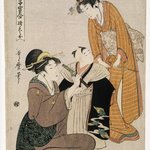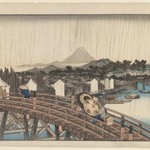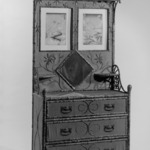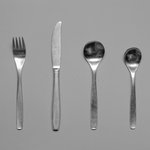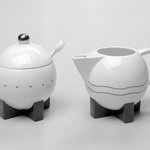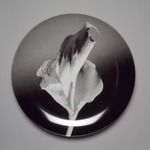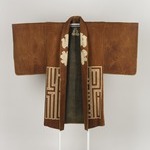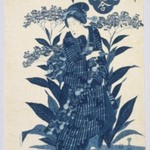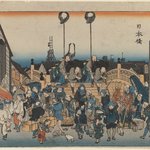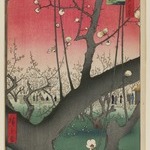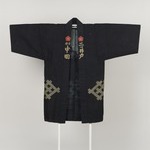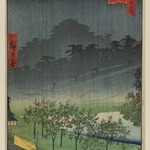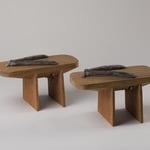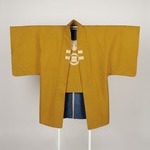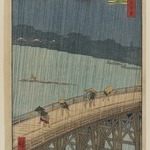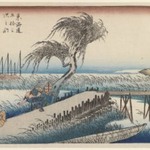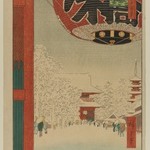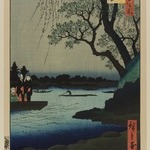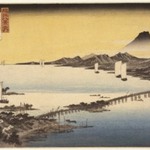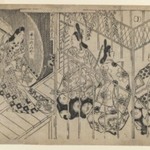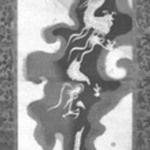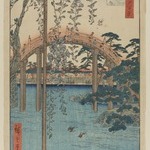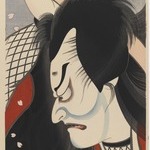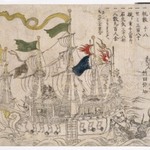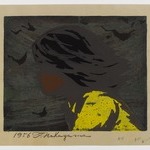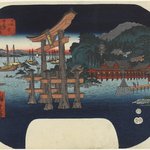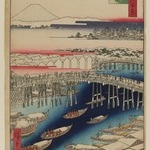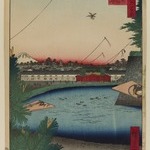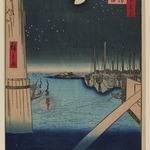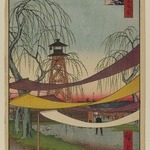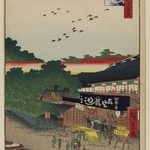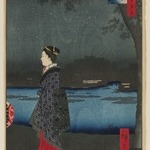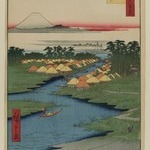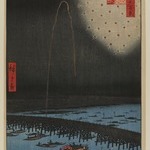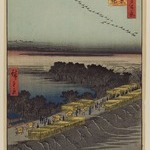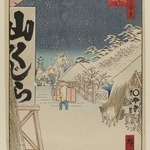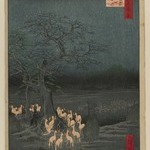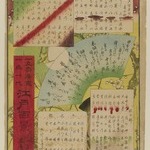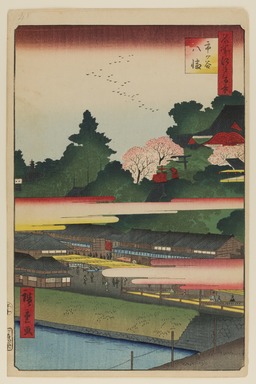
Ichigaya Hachiman Shrine, No. 41 in One Hundred Famous Views of Edo
Utagawa Hiroshige
Asian Art
Ichigaya Hachiman Shrine was not as culturally lofty as this image suggests. Within the shrine precinct itself was located a theater and numerous tea stalls, and the bustling street was known throughout Japan for the prostitutes who plied their trade there.
lchigaya Hachiman was located at the western edge of a long bluff that in the Edo period was one of the estates of the Tokugawa family of Owari (Nagoya), and a watchtower and part of the outer barrack walls of the Owari mansion can be seen at the upper left. It was there that the novelist Mishima Yukio performed his dramatic ritual suicide in 1970.
This print is one of three in the series that have been ascribed to Hiroshige II.
MEDIUM
Woodblock print
DATES
10th month of 1858
PERIOD
Edo Period, Ansei Era
DIMENSIONS
14 3/16 x 9 5/16in. (36 x 23.7cm)
Sheet: 14 3/16 x 9 5/16 in. (36 x 23.7 cm)
Image: 13 1/4 x 8 3/4 in. (33.6 x 22.2 cm) (show scale)



MARKINGS
Publisher: Shitaya Uo Ei
SIGNATURE
Hiroshige-ga
COLLECTIONS
Asian Art
ACCESSION NUMBER
30.1478.41
CREDIT LINE
Gift of Anna Ferris
PROVENANCE
Prior to 1930, provenance not yet documented; by 1930, acquired by Anna Ferris of Summit, NJ; 1930, gift of Anna Ferris to the Brooklyn Museum.
Provenance FAQ
CATALOGUE DESCRIPTION
Scene looks down on the Outer Moat of Edo Castle outside Ichigaya Gate (which is today Ichigaya station). In the street below there are tea stalls and various types of entertainment. Ichigaya was known throughout Edo for the prostitutes who plied their trade here, according to one 18th-century source). Above, behind a red gate and dark "torii" at the head of a steep stone stairway, are the red buildings of Ichigaya Hachiman Shrine. The red and yellow bordered cloud bands suggest a sense of distance and an aura of power around the shrine. The small yellow-roofed, lantern-lined pavilion, on the right, below the main shrine building, was one of the tea stalls, just outside the theater, located within the shrine precincts. In the Edo Period, Ichigaya Hachiman was one of the estates of the Tokugawa family of Owari (Nagoya). In the upper left there is a watchtower and part of the barrack walls of the Owari mansion, which became the Military Academy of the Japanese Army in the Meiji Period and at present are the barracks of the Self-Defense Force. It was here that the novelist Mishima Yukio performed his dramatic seppuku in 1970.
EXHIBITIONS
MUSEUM LOCATION
This item is not on view
CAPTION
Utagawa Hiroshige (Japanese, 1797–1858). Ichigaya Hachiman Shrine, No. 41 in One Hundred Famous Views of Edo, 10th month of 1858. Woodblock print, 14 3/16 x 9 5/16in. (36 x 23.7cm). Brooklyn Museum, Gift of Anna Ferris, 30.1478.41 (Photo: Brooklyn Museum, 30.1478.41_PS20.jpg)
IMAGE
overall, 30.1478.41_PS20.jpg. Brooklyn Museum photograph, 2023
"CUR" at the beginning of an image file name means that the image was created by a curatorial staff member. These study images may be digital point-and-shoot photographs, when we don\'t yet have high-quality studio photography, or they may be scans of older negatives, slides, or photographic prints, providing historical documentation of the object.
RIGHTS STATEMENT
No known copyright restrictions
This work may be in the public domain in the United States. Works created by United States and non-United States nationals published prior to 1923 are in the public domain, subject to the terms of any applicable treaty or agreement.
You may download and use Brooklyn Museum images of this work. Please include caption information from this page and credit the Brooklyn Museum. If you need a high resolution file, please fill out our online application form (charges apply).
The Museum does not warrant that the use of this work will not infringe on the rights of third parties, such as artists or artists' heirs holding the rights to the work. It is your responsibility to determine and satisfy copyright or other use restrictions before copying, transmitting, or making other use of protected items beyond that allowed by "fair use," as such term is understood under the United States Copyright Act.
The Brooklyn Museum makes no representations or warranties with respect to the application or terms of any international agreement governing copyright protection in the United States for works created by foreign nationals.
For further information about copyright, we recommend resources at the United States Library of Congress, Cornell University, Copyright and Cultural Institutions: Guidelines for U.S. Libraries, Archives, and Museums, and Copyright Watch.
For more information about the Museum's rights project, including how rights types are assigned, please see our blog posts on copyright.
If you have any information regarding this work and rights to it, please contact copyright@brooklynmuseum.org.
RECORD COMPLETENESS
Not every record you will find here is complete. More information is available for some works than for others, and some entries have been updated more recently. Records are frequently reviewed and revised, and we welcome any additional information you might have.
